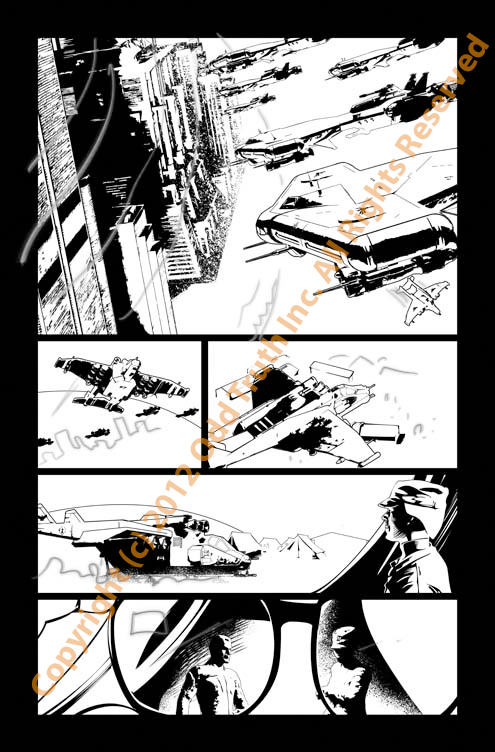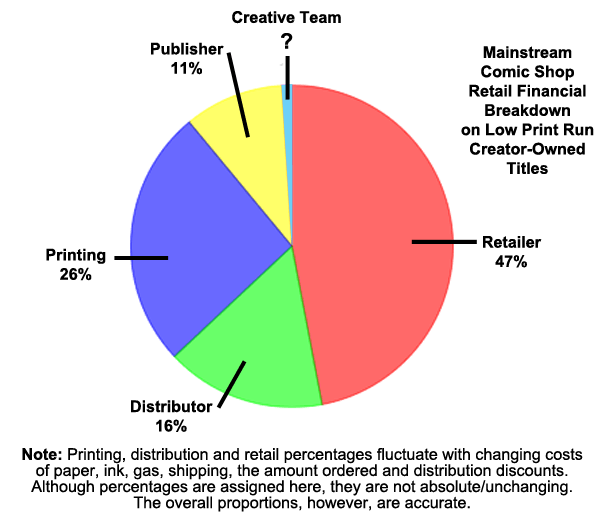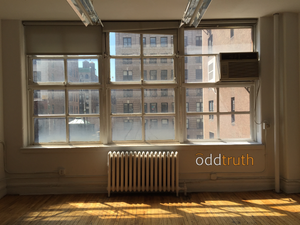Greetings everyone,
First, a couple of updates. We’re still working hard on issue 2 and, I have to say, I am thankful for Dropbox, otherwise we would have lost a lot more time and content thanks to Sandy. Here are a couple of inks to give you an idea of where we are going with issue 2. To give you a little context (and a small preview of what’s to come), this is the preliminary first page of issue 2, and it deals with an invasion of sorts.
Below is page 9. I wonder what secrets lie behind that vault? Hmm…

Now, onto other things. Around the indy comic book industry space, there was a post by Jim Zub that sheds light to the reality of creator-owned comic books. It is a great read and to those who thought would acquire easy fame and riches, hoping to be the next Walking Dead, it’s a sobering reminder of the reality of self-publishing. Jim Zub’s pie chart clearly summarizes his article:

We at Odd Truth can say that our percentages are similar and different in certain regards. First, as we’re still working on getting on comic book store shelves, our main retailers (iBookstore, Graphicly and Amazon, with Nook coming along in the next week or so) are online, and their percentages are different: some more, others less than 47%. As we are the creative and the publisher, our cut of the pie is slightly larger than “?”, but still not enough that any of us can quit our day jobs.
But even so, we feel there are vast areas of improvement that can help minimize cost to the overall production process, thus allowing one to have a greater piece of the pie.
(Hold on while I put on my engineer’s hat… There we go)
We’ll assume that we’re dealing with only the production process (script and art composition, as well as the composing process), and that promotion, marketing and distribution is handled separately.
It’s utterly important that the production team gets an editor. In our opinion and experience, having that third pair of eyes objectively looking at the product is priceless. The editor serves as “Quality Assurance”. Like all QA teams, you don’t necessarily need it, but when you have it the product comes out THAT MUCH BETTER. Also, the editor usually serves as the whip that gets everyone to march to the same tune, and provides the pressure necessary for some artists to “acquire” the muse “necessary” for inspiration (in our opinion, and in John Cleese’s , inspiration and creativity is something you can train yourself to experience at any time).
At the same time, communication among all components of the product creation (writer, artist, inker, colorist, letterer, etc) is paramount. Early and frequent communication allows for improvements and fixes to occur earlier in the production process. The earlier they can be addressed, the cheaper it is to rectify. Cheaper here may not necessarily mean that less money is spent (this all depends on how and what you negotiate with the creative team), but it certainly means that less time is spent fixing things down the line.
Also, try to find the necessary tools to ensure that there’s a constant dialogue amongst all members. We’ve used Celtx to share the script and we’ve utilized their notes and image tagging options to tag portions of the script, as well as their database options to provide more in-depth characterizations and locales that are not necessarily found on the script. We’ve also used other collaborative software like Teambox , Basecamp , Dropbox and many others to minimize the number of emails sent back and forth with files attached, assigning tasks and fixes to pages, etc. Less individual traffic means everything’s consolidated in one place, synchronized across all team member’s folders and readily accessible at all times.
Yet, none of this matters if the team doesn’t want to use it. As such, it is VITAL that you listen to the production team and find a method that works for all.
In our experience, having Dropbox and a system that allows everyone to stay up-to-date has been the best way we’ve been able to work remotely, thus saving on production costs as we don’t need to rent studio space to have everyone working under one roof. Yet, thankfully due to Skype, Google chat, etc, we are able to still maintain a sense of unplanned collaboration, as we are all willing to engage in this kind of collaboration. This is unusual, as unplanned collaboration is typically killed due to the lack of a common space. We’ve managed to make it work by switching our mindset, by considering ourselves constantly available to interruption by our teammates, except at specific instances when we really can’t be (much like in the real world). It’s still a work in progress, but we feel we can make strides in this regard.
At this point, we should be worrying about compiling the issue. For print, it’s actually fairly straightforward: most printers accept PDFs, so your main concern would be to ensure that your page size conforms to their specifications. Specifically, printers have what’s known as a “bleed area”, where the printed item will be trimmed in production. You want to ensure your comic book is inside the bleed area. The other concern one should have is the type of printer one uses. The two options, digital
and off-set printing. The one main benefit to off-set printing is that your costs decrease as your order number increases.
As for digital, it becomes a bit more complicated, as your comic book needs to be converted into a specific format (which depends on the distributor you’re submitting to). Most accept EPubs, as it is a standard for books. Yet, submitting the EBook on its own doesn’t allow you to provide the best experience for the devices that will read your comic book. Also, in some instances, even EPubs need to be converted further (such is the case with Amazon). Using third parties to handle your conversion, like Graphicly, is a good idea, but introduces other difficulties as well and, most importantly, you cede control over the final product to your third-party. It’s been our experience that these conversions aren’t always the best they can be, and how comic book are categorized on their respective digital stores will significantly affect how they are found by your audience. Yet, even submitting your comic books to these stores directly doesn’t guarantee much improvement, as none of them are geared or receptive to the sale and distribution of single-issue comic books (unless you are DC Comics).
But that’s a discussion for another time.
That’s all for now. I hope this has been informative for all creators out there. Next week, I’ll expand on digital distribution and what we as indy publishers can do to make ourselves better known out there.
Best,
-Nick D.

